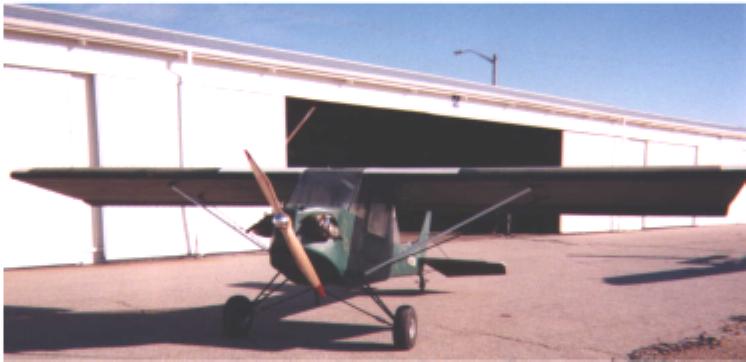INTRODUCTION TO THE M-19
revised March 3, 2002
revised March 3, 2002
The Barnard M-19 "Flying Squirrel" is the sport pilot's airplane, an affordable, simple, reliable homebuilt airplane that brings with it a return to flying the way it was intended to be. Many other homebuilt and kit designs have made these same claims, but very few have delivered. This one does, and Marvin Barnard is the main reason why.
The M-19 was conceived and designed by Marvin R. Barnard, a very talented and determined man who has managed to focus on the most basic of motivations for homebuilding: to create an airplane which can be built quickly and easily using basic materials and methods, at the lowest possible cost. Marvin built and tested the prototype, and flies it regularly. His is no "proof of concept" or "mock-up" of something which might some day be developed and flown, but rather a working, flying airplane certified in the experimental, amateur-built category. This puppy can hunt.
The M-19 was never intended to be a trophy winner in any category but one: SATISFACTION. Building and flying this airplane should satisfy the pilot's desire to fly a basic standard airplane, and satisfy the builder and experimenter's desire to... build and experiment!
The M-19 will probably be out of its element if you put a full electrical system, leather interior, glossy paint job, IFR panel, fairings, or other dress-up items in or on it. This airplane will be happiest with you out flying it, not fiddling with it in the hangar or shop, or tacking some extra weight onto it. You want to go dodge some clouds and scout some terrain... so does the Squirrel! You want to fly for an hour or two without having to go through a half-hour preflight... so does the Squirrel! You want to go to a fly-in somewhere over the county line, and not have to save up for a week or two to afford the gas... the Squirrel can do it!
Ask yourself why you took up flying; list all the reasons. The Squirrel can probably answer most of those except for flying fast and carrying passengers. The M-19 represents "stick and rudder" flying at its finest, and will keep your piloting skills where they need to be. This is not an airplane that you can put in a climb, intercept a vector, and engage the autopilot; this airplane needs for YOU to fly it. There are no optional extra controls, trim wheels, engage/disengage accessories- this airplane needs for you to be the pilot. Similarly, there are no kit-in-a-box prefab parts; this airplane needs for you to be the builder. Whatever needs to go on this airplane must be fabricated, but the plans and manual are very detailed and complete, and the determined builder should have no trouble fabricating and assembling the airplane from the information supplied. Materials lists are provided, and Wicks Aircraft Supply has assembled a fairly complete package of materials which can be purchased instead of "shopping around" for bits and pieces, but the beauty of this airplane is that you can build it inexpensively by using your own ingenuity and "outsourcing skills" (scrounging) to get what you need to build it. Aviation-grade materials and techniques are specified, but the individual builder is the essential ingredient to producing a strong, reliable, airworthy aircraft.
The M-19 is a single-place, high-wing, conventional fixed gear (taildragger) aircraft powered by the Volkswagen engine converted for aircraft use. Recommended horsepower is in the range of 50-60 HP. Any less than that will probably work, but will be borderline in performance. Any more than that will be extra weight and fuel consumption, and won't gain you much of value. The basic design does not include brakes, wing flaps, or trim. This is a native-skills, 3-axis/control aircraft designed for VFR day-only flying. Flight into known icing conditions is prohibited! ;o)
See various views and studies of the M-19
THE BASIC M-19 CABIN STRUCTURE
The airframe is constructed of wood, with rigid foam infill panels and a fiberglass/resin covering inside and out. The wings use wood spars with rigid foam ribs and wing surfaces, also with a fiberglass/resin covering. The ailerons are full-span. All wing and airframe fittings and struts are of steel. The aircraft's fuel tanks, about 8 gallons total, are contained in the wing rib bays. The wings fold for trailering and storage. The main control is a center stick (anything else would be out of place on this airplane!)
Complete information is available from Marvin Barnard (see address and contact information below), but here are the essentials:
*Wing Span.................24 ft.
*Wing Area................104 sq. ft.
*Length..................16.1 ft.
*Height...................5.4 ft.
*Wing Loading.............7.5 lb/sq. ft.
*Power Loading.............12 lb/HP
*Gross Weight.............800 lbs.
*Standard Empty Weight....494 lbs.
*Maximum Useful Load......306 lbs.
*Optimum Cruise Speed.....................80 MPH
*Stall Speed..............................38 MPH
*Takeoff Ground Run (minimum)............500 ft.
*Takeoff Distance Over 50 ft. Obstacle..1000 ft.
*Landing Roll............................500 ft.
*Vno.......................80 MPH
*Vy........................60 MPH
*Vx........................55 MPH
*Vso no flaps..............38 MPH
*Vr........................40 MPH
*Vne.......................90 MPH
P.O. Box 24
Norman, IN 47264-9703
e-mail: MRBarnard@webtv.net

Here's a closing shot of Marvin's airplane, taken early in 2002, showing a few items currently being experimented with. A skullcap prop spinner (picked up a MPH or so); extruded plastic streamline fairings on the main lift struts (picked up another MPH or two), and a hand-modified prop (picked up some static RPM but not much else). Marvin just keeps trying this and trying that, but keeps coming back to the same basic, fun-to-fly little airplane!
Return to Oscar Zuniga's Aviation Homepage